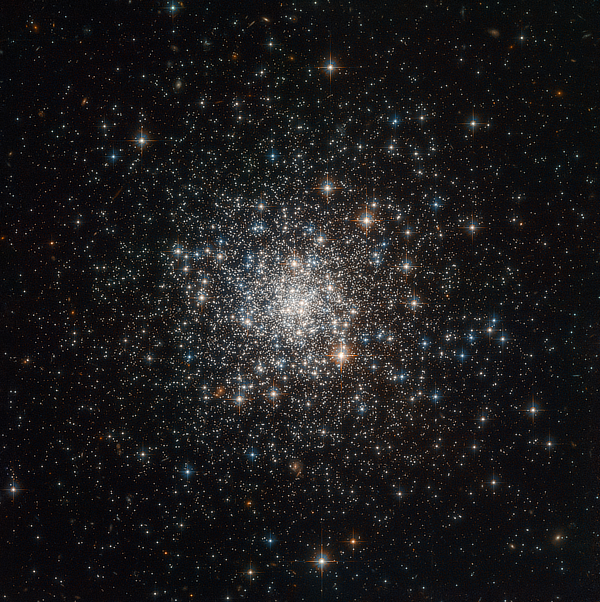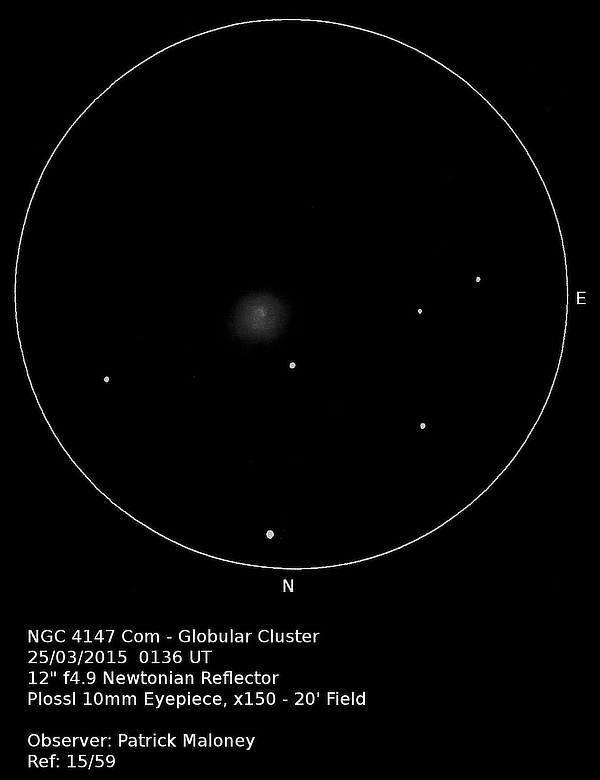NGC 4147 in Coma Berenices
March 2024 - Nebula and Cluster of the Month
March is the month when the nighttime side of Earth begins to face away from the Milky Way. Ahead of us are the Spring months, stuffed with distant galaxies. This is good, of course. We all like a nice galaxy.
It’s not so great for those of us who have to present a cluster or nebula of the month. They are vanishingly rare in the northern hemisphere at this time of year. The southern hemisphere is far better served. Due south of Virgo, and permanently below our southern horizon, lie the glorious Milky Way fields of Crux Australis and Centaurus.
Here in the north, March offers but four objects relevant to this column, and one of those is a mere asterism (NGC 3231 in Ursa Major).
Our object for this March is a globular cluster in the constellation of Coma Berenices - more famous for its galaxies. It is somewhat isolated from its fellow globular clusters, being about 70,000 light-years from the galactic centre. The object is NGC 4147 (also catalogued as NGC 4153). It was discovered by William Herschel on the night of 15th February 1784 (and then again, accidentally, on the night of 14th March of that year, accounting for the double entry in the NGC). He thought it to be bright, placing it in his first class (bright objects) as 11H.I and as 19H.I. He anticipated the descriptions of many observers to come by describing it as Very bright, pretty large, gradually brighter towards the middle.
A century later, the NGC description had barely changed: Globular, very bright, pretty large, round, gradually brighter towards the middle, easily resolvable.
From a visual perspective, that about says it all.

A recent study1 by Sneh Lata of Arybhatta Research Institute of Observational Science in India et al identified 42 variable stars in the cluster, 28 of which were new discoveries. Most were RR Lyrae stars (pulsating variables of spectral type A and F). RR Lyr stars are often called ‘cluster variables’ and are used as standard candles, like delta-Cepheid stars. They are common in globular clusters. The study enabled the team to reassess the distance of the cluster from Earth. Previously believed to be 61,000 light-years, this figure has now been reduced to 56,000 light-years.
The location and relative remoteness of NGC 4147 suggests that it was once a member of the Sagittarius Dwarf Spheroidal galaxy, which was once a satellite galaxy of the Milky Way before being drawn into our Galaxy and tidally disrupted. Most of its former mass now lies as an elongated stream in Sagittarius. The Sagittarius Dwarf Spheroidal galaxy was believed until quite recently to have contained at least nine globular clusters, the largest and brightest of which is Messier 54. M54 may, indeed, be the actual core of the galaxy. Analysis of Gaia data has, however, revealed at least twenty more.
For those who like contrasts, NGC 4147 is well placed, not quite equidistantly, between two galaxies, NGCs 4064 (1.4° to the west) and 4293 (2.6° to the east). Whilst these three objects are of comparable magnitude, they are not equally easy to see. I briefly quote here from my own observations:
NGC 4064 (barred spiral galaxy, mag 10.7) ‘Pretty faint, though... visible to direct vision at x83.’
NGC 4147 (Class VI globular cluster, mag 10.4) ‘Very bright... brighter middle.’
NGC 4293 (barred spiral galaxy, mag 10.3) ‘Only very dimly visible to direct vision.’
This is largely due to a quantity known as ‘surface brightness’. Surface brightness is measured in units of magnitude per square minute or magnitude per square second. I find the former far more useful, though unfortunately, magnitude per square second is widely quoted. Magnitude per square second tends to be down in the 20s, whereas using square minutes seems far more meaningful. For example, the surface brightness of NGC 4064 is 13.3, and of NGC 4293 is 13.2.
I have noted before that the most important measurement of how visible a globular cluster is, is its concentration class. The classes run from I to XII, in decreasing order of concentration (note that this is incorrectly reversed in the Field Guide to Uranometria).
NGC 4147 is a class VI globular cluster, placing it right in the middle of the concentration classes. It has a small angular diameter (just about 4’). Taken together, these suggest that NGC 4147 should be fairly easy to see, and so it proves.

My observation of this object was made on a particularly cold night in March 2015 (the object glass of my finder scope was iced over) from my home location in the happy days before the advent of LED street lighting. I recorded a NELM of 5.8 that night. I can barely get to 3.0 these days.
I followed the path trodden by many previous observers, describing the globular cluster as Pretty bright but not particularly large. Brighter middle. Not resolved but spangly. No resolution even at x375.
The brightest star in the cluster is of magnitude 14.5, so resolution was a little beyond my equipment and conditions. Can you do better?
| Object | RA | Dec | Type | Magnitude |
|---|---|---|---|---|
| NGC 4147 | 12h 10m 06s | +18° 32’ 32” | Globular cluster | 10.4 |
References:
- Photometric observations detect 28 new variable stars in NGC 4147 (2019, May 29) retrieved 26 February 2024 from https://phys.org/news/2019-05-photometric-variable-stars-ngc.html